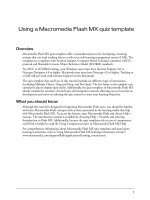Tài liệu Avoiding Locking Scenarios docx
Bạn đang xem bản rút gọn của tài liệu. Xem và tải ngay bản đầy đủ của tài liệu tại đây (6.28 KB, 3 trang )
Avoiding Locking Scenarios
• Best Practices – Application
– Use least restrictive isolation level that maintains the data integrity
requirements of the application
– Reduce Isolation level of specific statements by using statement level
isolation (i.e., WITH clause)
– CLOSE cursors WITH RELEASE to free locks prior to end of
transaction
– Perform updates as close to the end of the transaction as possible, to
reduce exclusive lock duration
– COMMIT frequently to release locks
– Avoid multiple applications accessing the same tables, but acquiring
locks in different orders (Access patterns should be similar)
– Avoid having multiple processes that access the same table for both
reads and writes within the same transaction
Avoiding Locking Scenarios
• Best Practices – Database
– Avoid lock escalations by increasing DB CFG parameters
LOCKLIST and/or MAXLOCKS
– Avoid lock timeouts:
• Adjust the DB CFG parameter LOCKTIMEOUT or use the SET
CURRENT LOCK TIMEOUT command
– Avoid deadlocks:
• Reduce row blocking during index and table scans:
– DB2_SKIPINSERTED to skip/ignore uncommitted inserted rows
– DB2_SKIPDELETED to skip/ignore uncommitted deleted rows
– DB2_EVALUNCOMMITTED to defer locking until row is known to
satisfy query. Uncommitted data will be evaluated. Skips deleted rows
on table scans.
More Useful Registry Variables for
Locking
• DB2_KEEPTABLELOCK
– allows DB2 to maintain the table lock when an
uncommitted read or cursor stability isolation level
is closed. The table lock is released at the end of
the transaction
•
DB2_MAX_NON_TABLE_LOCKS
– defines the maximum number of NON table locks
a transaction can have before it releases these
locks. Because transactions often access the
same table more than once, retaining locks and
changing their state to NON can improve
performance
•
DB2LOCK_TO_RB
– specifies whether lock timeouts cause the entire
transaction to be rolled back, or only the current
statement









